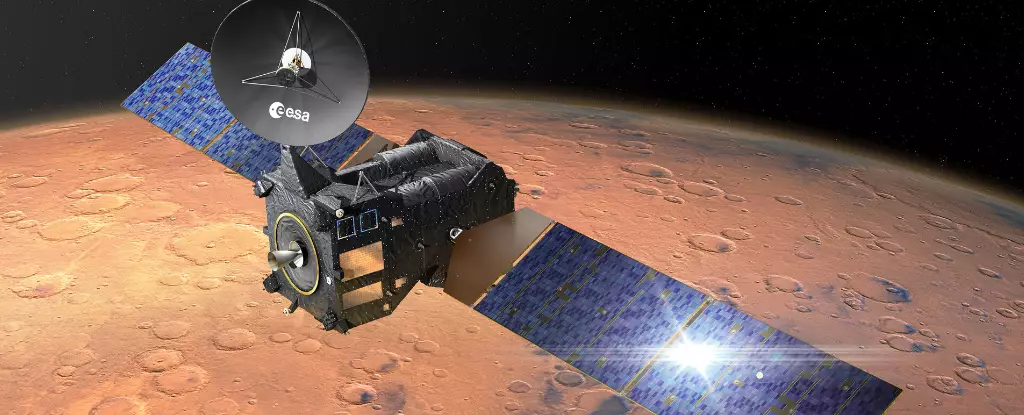In an ambitious endeavor to bridge the gap between humanity and the cosmos, the European Space Agency (ESA) launched a unique multidisciplinary initiative in May 2023. The Exomars Trace Gas Orbiter (TGO), which was set to orbit Mars, sent a transmission back to Earth. This was not just any ordinary comms signal; it was designed to mimic a potential extraterrestrial message and engage the global community in a unique scientific challenge. This project, termed “A Sign in Space,” aimed to gather citizen scientists from various backgrounds to join efforts in decoding the enigmatic signal and unlocking its mysteries.
The project was notably inspired by the visionary literary work “Cosmicomics” by Italian author Italo Calvino, showcasing his innovative approach to intertwining science with narrative fiction. By drawing on the imaginative principles explored in Calvino’s writing, the project sought to captivate the public’s attention and stimulate their curiosity about the deeper secrets of the universe.
This groundbreaking initiative brought together several esteemed institutions dedicated to the pursuit of knowledge in astrobiology and radio astronomy. Collaborators included the SETI Institute, Green Bank Observatory, ESA, and the Italian National Institute of Astrophysics (INAF). Their joint efforts provided the necessary framework and expertise to guide citizen scientists through the complexities of this extraterrestrial messaging endeavor.
The project’s unique approach to citizen engagement reignited excitement in the scientific community, as more than 5,000 individuals, including amateur enthusiasts and seasoned scientists, embarked on the challenge of decoding the signal. The democracy of knowledge in this context fostered a bustling online community where participants pooled their varied skills, tools, and perspectives in hopes of deciphering the raw data received from TGO.
The quest to decode the extraterrestrial-inspired message was rife with challenges and complexities. Initial attempts to decipher the signal came from three dedicated radio astronomy observatories, which intercepted the message bursting with encoded information. However, the task of translating this complicated data required not only technical prowess but also creative ingenuity.
After an intense ten-day effort, the community’s collective surge of determination yielded results, with many participants grappling to extract coherent meaning from the chaotic signal. The real breakthrough occurred when Ken Chaffin and his daughter Keli, a remarkable father-daughter duo from the United States, successfully cracked the code after engaging in countless simulations. Their perseverance allowed them to unveil a series of white dot clusters accompanied by geometric lattices—an artistic representation seemingly invoking the foundational building blocks of life.
What Ken and Keli uncovered was a visual representation of five amino acids, fundamental components that constitute life as we know it. Their findings captured the imagination of not only the scientific community but also those captivated by the allure of extraterrestrial life. The Chaffins’ submission included a detailed explanation of their mathematical simulation strategy, which employed the Margolus reversible 2×2 block cellular automata—a whimsical yet effective method for decoding the signal.
The decoded image represented not only a scientific breakthrough but also an artistic triumph. The retro-style depiction of amino acids, illustrated through a universal diagram notation, encourages deeper reflections on the essence of life across the cosmos. Ken’s accompanying message described his engagement with the encoded data and affirmed its apparent clarity to peers versed in chemistry.
With the decoding phase concluded, the significant inquiry lies in interpreting the implications of this signal. What does it mean for humanity as we stand on the precipice of potentially making first contact with an otherworldly civilization? As the Chaffins opened the floodgates for public discourse, the team at “A Sign in Space” encouraged individuals to analyze the deciphered message further and share their interpretations on the project’s Discord channel.
Participants are invited to engage in inventive analyses using the disclosed methodologies while linking their interpretations to various narratives—ranging from theories of cultural exchange to considerations of existential threats posed by potential extraterrestrial encounters.
Through this extensive initiative, humanity has unlocked a deeper dialogue about our readiness to engage with the cosmos. The project opens multiple avenues for cooperation and imaginative exploration, fostering a greater understanding of our place in the universe. With the lessons learned from this unique venture, the time may soon arrive when we truly make contact with beings beyond our world, but for now, the inquiry continues.


Leave a Reply